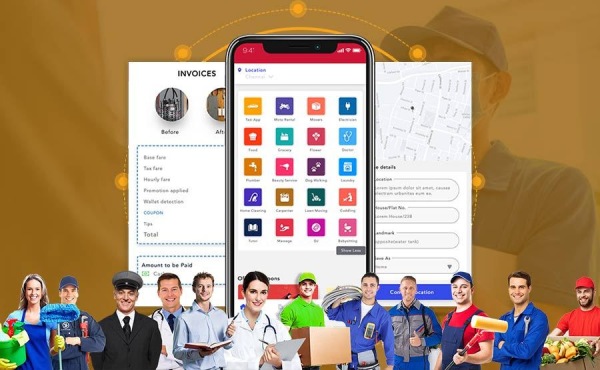The on-demand sector is one of the opportunistic marketplaces in contemporary times, which has led to intense competition. Yet, the on-demand sector has room for budding on-demand service marketplace businesses. You can use the opportunities prevailing in this sector to your advantage by launching a Gojek clone app that can feature a diverse number of on-demand services.
Top reasons for the intense growth of the on-demand service marketplace sector
- The facility of choosing different types of services and service providers from the same app.
- Advantage of availing of cost-effective services when compared to traditional services.
- On-demand services coupled with an easy-to-use booking app strengthens the reliance of users on on-demand services to a greater extent.
- The increase in the number of gig workers also chips in to the intense growth of on-demand services.
What are the categories of services in the on-demand service marketplace?

- Transportation
If you take the on-demand transportation service, there is no need to elaborate on its growth. From the last decade, on-demand transportation services have been marking surreal growth and have shunned traditional transportation services to a greater extent. To reap success in a precise time and also thrive in the marketplace for a long time, follow the aggregator model like Uber.
- Travel
The desire to explore places throughout the globe will never settle down among travel enthusiasts. For them, finding accommodation can be difficult at times. So, apps like Airbnb, booking.com facilitates accommodation booking by listing a pool of hotels, tourists places, etc., around the world.
- Education
E-learning apps have become the main source of education for students in these pandemic times. The number of students registering for online courses has been increasing, and so are the number of e-learning apps. Online education apps not just provide courses but also provides the facility of booking in-person tutoring services so that students will get direct assistance from tutors. The popular platforms that come under this umbrella are Coursera, Udemy, BYJUS, etc.
- Freelancing
Previously, under the reasons for the rise of on-demand services, we discussed the rise of gig workers. The same applies here. The rise in the number of people preferring gig works in comparison to full-time works has paved the way for the growth of freelance platforms.
Through freelance platforms like Freelancer, Fiverr, Upwork, etc., one can find local service as well as global service providers and get their work done.
- Healthcare
Fixing appointments at preferred time slots, one-to-one online consultation with preferred doctors, ordering medicines, etc., have been such a simple task through the introduction of online healthcare apps. The online healthcare apps are boon to the elderly population as well as people who dwell in remote regions, where getting medical help is an arduous task,
- Food and grocery delivery
Visiting restaurants has been shunned by the effects of the pandemic. But thankfully, the food delivery apps facilitate instant deliveries of orders through professional delivery persons. Likewise, buying groceries has been made simpler with online grocery delivery apps like Instacart, Grofers, etc.
Now, we will head to the next subheading, in which we will discuss the development stages of your on-demand services business. Developing from the scratch is not the only option, entrepreneurs can also launch the multi-services app from Gojek clone app solutions.
Development stages of your service marketplace business initiative
Stage 1: Research
The initial stage is when you perform research to perceive your target people and start drafting a plan on how to address their needs. Collecting the demographic information will help you as you can sort out your target people easily. The research phase also includes perceiving your rivalries’ offerings and their user base.
After getting accurate information about your target people and rivalries, you have to proceed with the business model selection.
Stage 2: Select a suitable mode of business operation
How you will carry out your business is the second question you have to ask yourself. Every business operates on the basis of certain criteria. For instance, some will run a business in partnership with other businesses. Or some will solely run a business. It is the same in the on-demand services marketplace. There are aggregator and individual models in the on-demand services business.
Choosing the aggregator model means you will run your business in association/partnership with third-party service providers. If you choose the individual model, then you look after your business solely.
Stage 3: App development

On-demand services business can be carried out easily by investing in white-label apps. A ready-made and the rebranded app is called a white-labeled app. The white-labeled and pre-built apps are the best as they enable quick launch.
Like how you have to decide the business model, you decide on the stack of features as well. Here comes the play of Minimum Viable Product. You may question the purpose of the MVP.
First of all, your app needs to gain awareness among the target people. After that, once they start using your app, they will leave feedback regarding the functionality or the overall experience. So, through the response you receive from app users, you can perceive the users’ choices as well as the app’s working accurately.
Stage 4: Optimization
So, from the previous stage, where you deploy the MVP, you will collect the feedback and process them. Processing the feedback from the users is the next step, which can also be termed optimization.
For optimizing your app, you must measure the performance on app stores, work on adding extra features, and also removing unnecessary ones.
Stage 5: Retention
Retaining users requires double the amount of effort, which is even more difficult in the case of on-demand apps. There are multiple metrics paired with user retention. First of all, your app must give a smooth user experience. Next, if you are employing the aggregator model that lists service providers, then those providers must be reliable. As the business admin, you need to make sure that providers are reliable by doing background checks.
Other than these imperative retention metrics, you can credit discounts and rewards points for users based on their eligibility criteria.
Summing up, as elaborated here, you can launch a service marketplace app like Gojek that focuses on providing different services in a single app.
